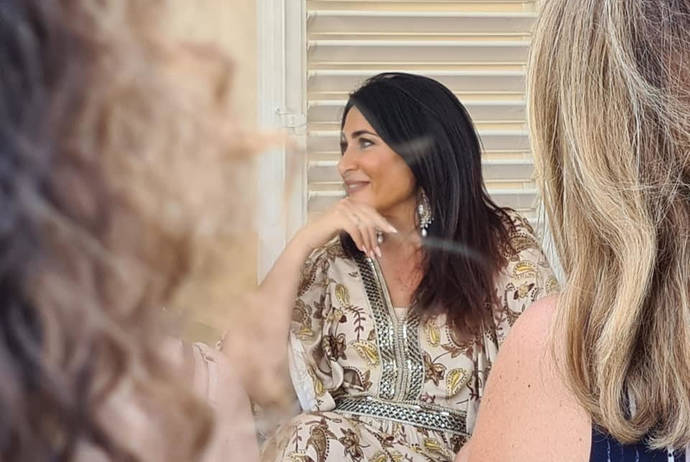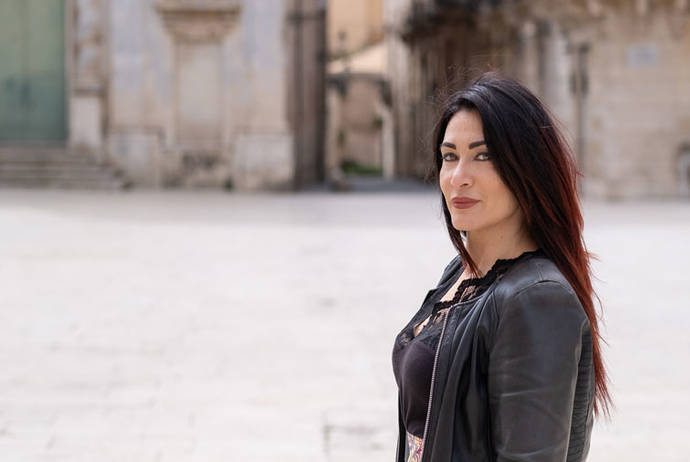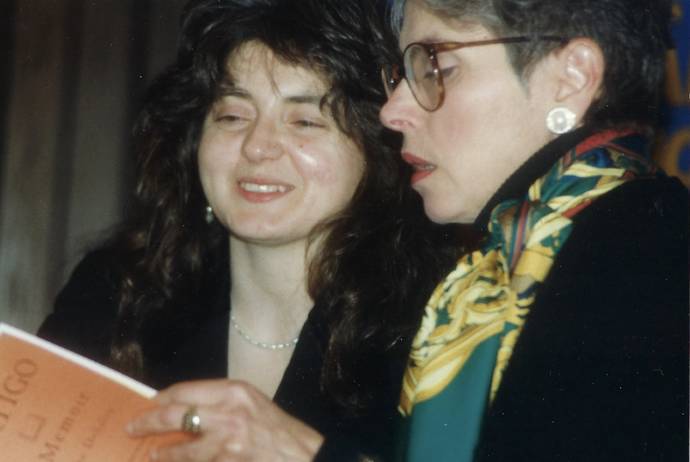Sicilian women are at the center of Giusy Scicca’s Virità (Edizioni KalóS, 2021), a book of myth, history, and legend. In five sections, we meet in turn goddesses and saints; rulers and noblewomen; heretics and sinners; innovators and revolutionaries; artists, writers, and scientists. All Sicilian women, all extraordinary. Each of them tells their story in first person following carefully constructed individual introductions that give the reader the necessary historical, social, and biographical, context. Everyone will recognize Demeter, goddess of the harvest who, with her daughter Persephone, was worshipped in ancient Sicily. Or Saint Lucy, the saint who is well familiar to Italian immigrants and to whom many Italian American churches are devoted in the US. But most of the women Sciacca presents, and endows with their own distinct voices—from Bint Muhammad Ibn Abbād to Anna Saragola to Giuseppina Bologani to Virdimura de Medico--will be as unfamiliar to an American, including Italian American, audience, as they are vital to understanding and appreciating the richness and complexity of Sicily as feminine geography and symbol.
Your recent book, Virità, begins with these words: “Sicily is female. From whatever angle you look. In bi- or tri-dimensional perspective. On the artistic, cultural, and geographic front, Sicily is the Island-Female.” It’s a powerful, unequivocal statement. What are its origins in your intellectual and creative journey?
I love my island deeply. It has never been for me a mere geographic site, but a dimension of the soul and of the deep breath of time. Intense, multifaceted. A reservoir of images and suggestions that feed every creative idea. For years, I have been looking at the island from afar and, as often happens, in a paradox of inverted proportions, from a distance you yearn for and love her even more. I began studying, reading, researching. I needed to know her and myself. And this knowledge came to be as I retraced the steps of my people, of the cultures that came before Magna Grecia up to the beginning of the twentieth century. And yes, it’s the path of my mothers, of my sisters. To know that the blood that flows in my veins gave life to women of the caliber of the protagonists of Virità makes me more confident and self-aware as a woman.
It’s during this long journey through books, documents, and all kinds of sources that I understood that indeed Sicily is and has always been Female.
How did you come up with the idea for Virità? Can you tell us about the development of the project, whether you had a clear vision from the beginning or whether the initial vision has changed, and if so, how?
The process that led to Virità started long before the idea for the book. I cannot pinpoint the exact moment I started collecting materials. The writing, however, started about two years ago with a monologue I wrote for the theater. In fact, my first protagonist was Peppa La Cannoniera, chosen with a Catanese actress in mind. That is when I understood that “the voice” I had imagined worked. But it was necessary to find a form, a shape that could contain my “hybrid” narration. The monologue alone, written for the theater, while effective, was not enough. I also wanted to narrate the context and provide the historical information that would illuminate the context itself. The first-person narration represents the ideal compromise between theater and narrative.
How did you come up with the title? What does it mean and why did you choose it?
I thought a great deal about the title, with the support of my publisher. The entire project and the individual stories revolve around the term and concept of “Virità.” The truth that has come to us is not always the only possible truth. There are many other hypothetical truths, and different truths are not mutually exclusive. Truth becomes prismatic, relative, prospective. The version changes depending on who is telling the story, who is listening, who has lived it. It gets fuller with each voice.
The subtitle mentions singular and plural. Why was it important to emphasize this duality?
Talking about the concept of truth entails unraveling a red thread that connects all the protagonists. Perhaps it’s reminiscent of the braided hair on the book cover, forever a symbol of sisterhood. The truth of every protagonist multiplies in the name of an awareness and a coherence independent of the social and cultural background of each woman. It transcends a simple duality. We are talking of chorality and plurality. And if we want to push beyond that, through the duality, we transcend the physicality of the female body. What I am talking about--what my protagonists represent--is a feminine essence that does not necessarily exist only within the bodies of women. My vision comes from a contemporary, international, and inclusive feminism.
The use of pronouns is very significant in your writing. It truly captures this see-saw—or perhaps symbiosis? —of singular and plural. There is the narrating I of the author and the narrating I of each protagonist within the autonomous narrative spaces you create for them. Then, there is a collective Sicilian self—the “we.” Can you talk about the choices you made about narrative perspective?
Exactly—it’s a kaleidoscopic symbiosis. Multiple levels, multiple visions, multiple souls, multiple voices—including mine! —that bleed into one another, right inside and outside this collective Sicilian self. Truly, I had fun. It was compelling becoming each of them.
Your book makes room for history and myth, religion and science. How did you choose the principles that govern the structure of the book? And how did you choose your protagonists among so many important Sicilian women?
Sicily is multiform and multilayered. I wanted to represent as much as possible the richness of Mediterranean history and culture.
The selection of the women instead was difficult. To include one and decide to leave out another was even painful. In the end, I chose an egalitarian approach, and considered especially affinity, independent of titles and labels. I did not want to make distinctions based on social rank or education. I stripped them of their social roles, labels, and class to get to a feminine essence. For this reason, Saint Lucy can be next to an illiterate woman and Costanza of Sicily next to an exorcist. I gave voice to those I felt closest to me or those in whom, in some ways, also found myself.
Was writing about historical figures different from writing about mythological figures? How so?
To attribute certain thoughts and words to historical or mythological characters is, I believe, already an irreverent choice. For example, it’s certainly irreverent to give voice to women saints. But I also believe that the only way to reread history, with new perspectives and with a new awareness, is to speak the unspoken, that which can only be imagined--that is, the human aspect. So, in this sense, no, I did not distinguish between mythical and historical figures, I wanted them to be as human as possible.
Each of these figures is deeply anchored to Sicilian geography and landscape. Can you speak of the origins and significance of the idea of the Sicilian landscape as wholly feminine?
Sicily is Mother Earth. Every corner of Trinacria has been a cradle. Flourishing, welcoming, and the setting of autochthonous cults, myths, legends, and historical events. What else to imagine when the map of the island lends itself to storytelling in all its full splendor?
What kind of obstacles did you face while writing the book?
More than obstacles, I would say challenging moments, especially with linguistic choices. I did a lot of research so that all the protagonists would express themselves in a manner that was believable and authentic, through the cultural instruments that belonged to them and the language of the historical context in which they lived. A real obstacle was the pandemic, as for everything else. The last portion of my research took place digitally and via telephone. Luckily, I found librarians and employees at the registry offices and the archives willing to do the physical aspect of the research in my place.
For whom did you write this book?
I wrote it so as not to lose anything that mattered to me. To gift it. To my daughter, and all the daughters of this land so they may always know where they belong, which mothers and sisters preceded them, and so that they may learn from them. Yet this book is not for women only. Men, too, will be able to dive into these pages for at least two reasons: to discover the women with whom they have a shared history and because that feminine essence of which I speak doe s not necessarily live only within the body of a woman. Emotions do not have a gender.
I often found myself reading your book aloud. There is a beautiful, powerful poetic voice in your narration and in your reflections, and it confers a special quality to the book. How did you create such a lyrical voice?
I did not want a list of names. Or a catalogue. I wanted to dip my hands in the viscera of the story to bring to light the feminine soul. History is not a mere list of names; it is the lives of women and men in flesh and blood who have experienced feelings and emotions. Through lyricism, I wanted to show the sorrows, the tremors, the passions. Each of the voices is inhabited by a soul, including mine.
What does it mean for you to be a Sicilian writer--from a personal as well as literary point of view?
It is a privilege and a responsibility. Sicilian literature is like a school and the teachers are giants—it has always been this way. I am grateful and have learned from those who came before me.
In recent years, there has been a sort of renaissance of Sicilian women writers—even as there was already a powerful tradition of Sicilian women writers. In what way is contemporary Sicilian literature –of which you are a representative—different and living through aa special phase. What do today’s Sicilian women writers have in common?
I agree that today, more than in the past, Sicilian women writers are gaining recognition and success, nationally and internationally. I have read and have had enlightening conversations with many writers. In my opinion, to be a Sicilian woman writer involves a distinctive awareness based on the certainty of beauty, history, values in which one firmly believe and that are inseparable from the bond with our Island.
---
Note: This interview was conducted in Italian and translated into English by Edvige Giunta.
Edvige Giunta
Professor of English
New Jersey City University




































